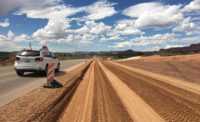
It has been only a couple of years since Kansas Dept. of Transportation (KDOT) engineers began using online storage for plans and project files. Washington state DOT just last year launched a website that publicly displays its projects' status and data. Until recently, the Iowa Dept. of Transportation did not have tools such as Spatial Network's Fulcrum, a field data collection tool.
That pace is expanding. Federal MAP-21 guidelines say state transportation agencies must demonstrate examples of innovative technology and upgrade their asset management systems—or risk losing some of their funding.
The shift comes as representatives of 44 industry and academic entities—including 26 involved in planning, design and construction—are calling for a wider embrace of asset-management technologies in a report called "Making the Grade." Terry Bennett, the report's author and Autodesk's chief infrastructure strategist, led the brainstorming session. "New engineering design and management techniques are tested and ready. All that is needed is the political and policy leadership to make it happen," it says.
Iowa DOT is now using iPads to collect asset data in the field and integrate it in a centralized database, says Shawn Blaesing-Thompson, geographic information systems (GIS) coordinator. "Even three years ago, there were no out-of-the-box solutions like Fulcrum," she says, referring to the popular app for field data collection.
The Iowa DOT also is working on its own app for customizing data collection regarding conditions of specific assets, such as guardrails, lights and crash attenuators, mapped with GIS.
"It's becoming all about the data," says Bruce Bourgoin, supervising engineer for AEC applications in the design division at ConnDOT, which, in 2011, vowed to go paperless with engineering reviews. "Decision-making processes have to be streamlined," notes Bourgoin.
ConnDOT wanted a seamless, interactive way to review project plans, says Mathew Calkin, ConnDOT transportation engineer. "You have an original PDF, and, after it's been bid, you need to make changes, which is another PDF," he says. "We worked with Bluebeam [a firm providing a PDF-based online collaboration system] to develop a feature where you can view them simultaneously [and] in order."
Taking a cue from ConnDOT, KDOT began deploying Bluebeam this year. "There is a lot of interest" throughout the DOT districts, Marquis says. "They're opening it and saying, 'I want this.' "
User-Friendly
Mobile tools such as iPads, iPhones and apps are facilitating data sharing. "It doesn't matter what software you use," says Blaesing-Thompson. "You get the data out of the system and into a central location so that anyone can look at it. We're breaking open the silos."




Post a comment to this article
Report Abusive Comment